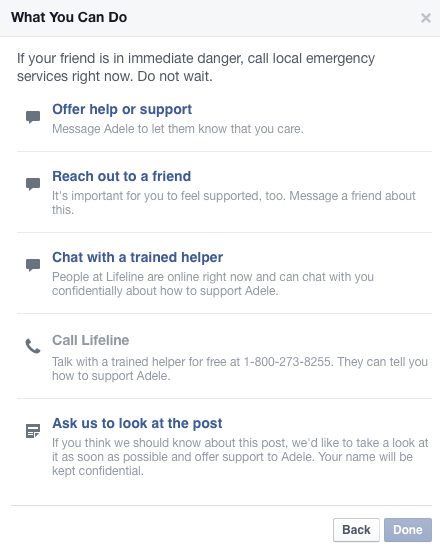Facebook users now have the opportunity to report a friend’s post as “hurtful, threatening or suicidal” by utilizing a new feature that shares online resources and support for suicidal individuals on Facebook.
According to the University of Washington, Facebook has partnered with Now Matters Now, the National Suicide Prevention Lifeline, Save.org and mental health experts at Forefront: Innovations in Suicide Prevention to give users the ability to draw attention to posts from distressed individuals.
Users who flag posts will arrive at the screen shown below, which allows them to contact another Facebook friend for support, message the suicidal person or connect with trained professionals at suicide helplines. Facebook will also review the flagged post, and if it is deemed a sign of distress, will set up a series of responses that could assist the potentially suicidal individual.

In this article, we discuss both the pros and cons of such a feature.
Pros:
Student opinion: I think it’s a good thing, because there are a lot of people who post statuses that I don’t feel comfortable commenting on, but I can tell something is going on,” senior Jack Brook said. “It’s good that you can do this anonymously without feeling awkward.”
1. It’s anonymous. Many Facebook users have hundreds of Facebook friends, many of whom may simply be acquaintances. However, the anonymity of this notification allows all Facebook friends to reach out to those who may be in pain, regardless of how close the two individuals are to one another.
2. There are options. The new service not only attempts to help the potentially suicidal individual, but it also offers help to the user who reports the post, because, according to Facebook, “it’s important for you to feel supported, too.” Due to this belief, Facebook presents the user with the ability to reach out to a friend, chat with a trained helper or even find nearby counseling services.
3. It shows you care. It is initially a Facebook friend who voices a sign of concern to the potentially suicidal individual. When the suicidal person receives a Facebook notification stating that someone believes they are in distress, the notification has the ability to make the suicidal person feel loved and cared for.
4. Difficult situations are placed in the hands of professionals. Often, many friends and family members are simply not equipped to handle a suicidal situation and they may become overwhelmed. The tools Facebook provide, however, aim to direct suicidal individuals to trained resources and facilities that know how to properly handle such a situation.
5. Better safe than sorry. Is there really any harm in reaching out to someone who is potentially upset? Often people just want to know that they are not alone and that they have support. This notification service assists in doing so.
Cons:
Student opinion: “It’s a terrible thing,” sophomore Johnny Rohrbach said. “It’s a complete invasion of privacy. I think you should be able to express yourself freely without people recommending a psychiatrist to you. If you want help, you should be able to seek it out yourself.”
1. It can be abused. Just like any other feature on Facebook, this feature could easily be used as a joke. Any status could theoretically be reviewed, soon turning this feature as a new way to “poke” friends. The service could be overwhelmed with false requests, making it easy for researchers to overlook any real inquiries.
2. It’s an invasion of privacy. Many see Facebook as a personal space for sharing posts, photos and information to friends. Giving users the ability to report a post, even if it is to be reviewed by professionals, is an invasion of privacy for those who want to keep their posts within their friend group. On top of this, a professional who knows nothing about the potentially suicidal individual shouldn’t be allowed to deem a Facebook post suicidal if that person has absolutely no background on the individual.
3. It’s limited. This feature only works for people who post statuses. If someone posts a picture or shares a wall post, this same feature would not be available.
4. It is difficult to access. To initially report a status, one must click on “I don’t like this post,” then “I think it shouldn’t be on Facebook,” then “I think they might hurt themselves,” and finally “It’s hurtful, threatening or suicidal.” It takes many clicks to report such a post and it can often be difficult to decide which of the multiple choice options is most suitable for the post. The complexity of the reporting process may deter users from reporting potentially harmful posts.
5. It can make people feel uncomfortable. Because some people utilize Facebook as a public journal or blog, there may be Facebook statuses with emotional content. Thus, some Facebook users may report these posts as a cry for help. The report may offend the original Facebook user who simply wanted to record his or her feelings. It may also lead them to change their posting behavior in the future.

